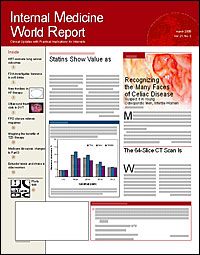The 64-Slice CT Scan Is Revolutionizing Imaging
When a patient with chest pain presents to the emergency de?partment, the differential diagnosis would include coronary artery disease (CAD), dissected thoracic aorta, and pulmonary embolism. Differen?tiating between these causes has until now often been a challenge. But imaging technology is advancing quickly. Physicians now have a new tool that can facilitate the differential diagnosis?64-slice computed tomography (CT), which was ap?proved late in 2004 and is now being introduced to many hospitals and radiology facilities.
This noninvasive application of CT technology offers fast scanning capability that was not previously available. In a single rotation, the CT scan creates 64 high-resolution anatomical image cuts that are as thin as a credit card and form a 3-dimensional view of the internal organs. The 64-slice CT is able to capture images of an organ such as the beating heart (but without the heart movement) or perform whole-body trauma scans in seconds. In addition to providing better im?ages, its speed is significant because it shortens breath holds during the scan, which can be a boon for geriatric patients.
Another advantage is the 64-slice CT's advanced ability to look at the internal anatomy, including coronary arteries, noninvasively. Previously, evaluation for peripheral vascular disease, for example, necessitated inserting a catheter into the groin. This new system requires only an intravenous line to inject the contrast.
Among the many US facilities introducing the new technology is the Hospital of the University of Penn?sylvania in Philadelphia, where officials expect that it will provide physicians with quick results that will enable them to identify the 15% of patients whose chest pain is due to a heart attack.
"Normally when a patient comes into the emergency department complaining of chest pain, an EKG is performed, blood tests are done, the pain is treated, and then the patient is admitted to the hospital for further testing," said Harold Litt, MD, chief of cardiovascular imaging in radiology at the Hospital of the University of Pennsyl?vania. "But now, after assessing the likelihood that it's actually coronary artery disease causing the chest pain?within 2 or 3 minutes we can tell whether the patient has coronary disease and needs to stay in the hospital or if he can be sent home."
The entire test takes approximate??ly 5 minutes. In?ves?tigators com??pared the ac?curacy of the 64-slice CT scan with invasive cor?o?nary angio?graphy in a recent study published in the Euro?pean Heart Jour?nal (2005;26: 1482-1487), which ex?amined how precisely this new technology assessed hemodynamically significant stenosis of coronary arteries.
A total of 67 patients (50 men, 17 women) with suspected CAD underwent both 64-slice CT imaging and invasive coronary angiography. All vessels >=1.5 mm were considered for the evaluation of significant stenosis. Invasive angiography identified 47 patients with significant coronary stenoses with 18% affected segments. The 64-image CT scanning system identified all 20 patients without evidence of significant stenosis on invasive angiography. Overall sensitivity for classifying stenoses was 94%, specificity was 97%, the positive predictive value was 87%, and the negative predictive value was 99%.
However, all that glistens is not gold. There are currently no standards for determining under what conditions the use of the new scans is most appropriate, and for which patients. In addition, the technology has advanced so quickly that many technicians have not received the proper training for using the new CT machines. In addition, although ap?proved by the FDA, the benefits of the new technology still need to be tested in more rigorous studies.
